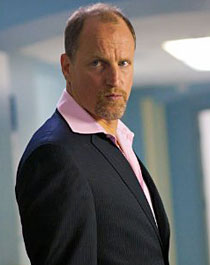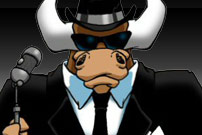 With the temperature dropping, it's time to find someone to keep you warm. Find your hookups with our online dating guide!
With the temperature dropping, it's time to find someone to keep you warm. Find your hookups with our online dating guide!

Woody Harrelson
Celebrities Home / Entertainment Home
Though first known to a major audience as a comic performer – as Woody Boyd for eight seasons on “Cheers” –Woody Harrelson has proven over time to be a riskier actor than most. He’s showcased his range and depth in dark explorations like “Natural Born Killers,” “Palmetto,” and “The People vs. Larry Flynt,” but also been just as willing to do something comic like “Kingpin” or “Semi-Pro.”
Woody’s childhood is oft told, and the tragedy of his father no doubt shaped Woody’s worldview. Woody’s parents divorced in 1964 when their son was three. Moving with his mother from Texas to Lebanon, Ohio (where Woody would spend his youth), Charles Voyde Harrelson was convicted for the murder of a federal judge in 1979 and sentenced to life in prison. He died in 2007. But for Woody, by 1983, he had a degree in English and Theater Arts from Hanover College in Indiana, and within two years would become the likeable bartender on “Cheers.” Dabbling between the sitcom and film work, Woody’s big screen career didn’t really begin to soar until late in the “Cheers” run with the 1991 release of “White Men Can’t Jump,” with Woody opposite Wesley Snipes.
When the “Cheers” run finally ended in 1993, Woody wasted no time in jumping into some meatier, heavier roles. Teaming with Oliver Stone, the two proved to be worthy collaborators in the intense “Natural Born Killers” in 1994. Two years later, Woody snagged his Oscar nomination for portraying Larry Flynt in “The People vs. Larry Flynt,” a critically acclaimed performance that also brought Milos Forman a Best Director nod. For the remaining years of the 1990s, Woody would appear in supporting roles, most notably the World War II epic “The Thin Red Line” and the Antonio Banderas boxing comedy “Play It to the Bone.”
Participating in activist causes and raising his daughters (three by 2006), Woody’s few appearances were limited to seven episodes on “Will & Grace” before returning to the big screen in 2003 with “Scorched” and “Anger Management.” In the next four years, Woody would appear in over a dozen projects, ranging from “A Prairie Home Companion” to “A Scanner Darkly” and as Carson Wells in the Best Picture “No Country for Old Men.” In addition to film and television, Woody has appeared on Broadway, a one-time owner of an oxygen bar in West Hollywood, and even climbed the Golden Gate Bridge to put up a sign reading, “Hurwitz. Aren’t ancient redwoods more precious than gold?”
Get the latest on Woody by following our Woody Harrelson tag.
 Tired of striking out? Check out these Dating Tips for all sorts of advice on how to finally get the girl! Also, we tell you all about some of the best online dating sites and how you can use them to hook up with more women!
Tired of striking out? Check out these Dating Tips for all sorts of advice on how to finally get the girl! Also, we tell you all about some of the best online dating sites and how you can use them to hook up with more women!
Woody on the Web
IMDb
Ultimate web resource page for Woody’s career.
Wikipedia
Decent bio tracing Woody’s youth, career, personal life and activist work.
Woody on the Screen
He’s Woody Boyd from 1985 to 1993 on “Cheers,” makes his film debut in “Wildcats” in 1986, is Hank Gordon in “Doc Hollywood,” Billy Hoyle in “White Men Can’t Jump,” part of the enormous cast spearheaded by Nick Nolte in “I’ll Do Anything,” Mickey Knox in “Natural Born Killers,” reunites with Wesley Snipes in “Money Train,” sports a Richard Dreyfussian mustache in “The Sunchaser,” is Roy Munson in “Kingpin,” and secures an Oscar nomination as Larry Flynt. He’s the insane sergeant in “Wag the Dog,” Sgt. Keck’s in Terrence Malick’s lyrical war poem “The Thin Red Line,” part of Spike Lee’s “She Hate Me,” FBI agent Stan Lloyd in the Pierce Brosnan vehicle “After the Sunset,” and Bill White in “North Country.” He’s married to Julianne Moore in “The Prize Winner of Defiance, Ohio,” Carson Wells in "No Country for Old Men," and Ernie Luckman in “A Scanner Darkly.” More recently, the actor has experienced a bit of a resurgence in films like "Zombieland," "2012," "Rampart," "The Hunger Games" and "Seven Psychopaths."
Woody Says
On playing Woody Boyd:
“I thought I might eventually end up doing some quality regional theater. Instead I end up with this role that everyone remembers. And hey, people who don’t even know me like me because of that role. That’s a pretty cool thing.”
On director Oliver Stone:
“I can remember that I was going to do this robber scene that was this long shot where I was jumping over counters and going through glass. Just before the camera was going to roll, he came up to me and said: ‘This shot took two hours to set up. Don’t screw it up.’ And then he yelled, ‘Action!’ That was his idea of a pep talk.”
You can follow us on Twitter and Facebook for content updates. Also, sign up for our email list for weekly updates and check us out on Google+ as well.










